Princess, painter, pioneer: Fahrelnissa Zeid at Tate Modern
A celebrated Turkish artist gets a major UK retrospective at the Tate Modern. "How is it that somebody so extravagant, charismatic, such a wonderful artist, could have been neglected?" co-curator Kerryn Greenberg tells TRT World.
MELIS ALEMDAR
27 JUN 2017
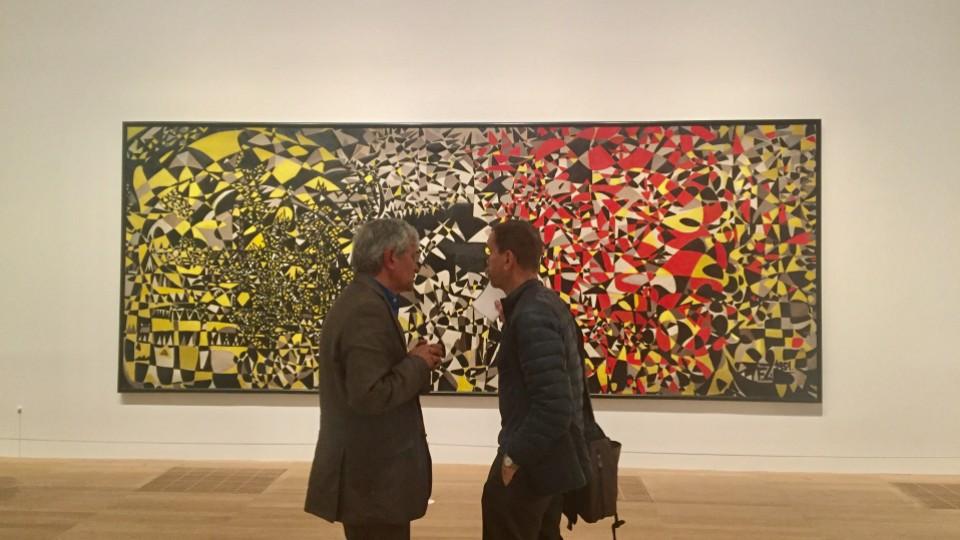
"My Hell", Fahrelnissa Zeid's 1951 portrait is on loan from Istanbul Modern to Tate Modern for a major retrospective. (TRT World and Agencies)
LONDON — A pioneer of modern art in Turkey, Fahrelnissa Zeid was born in 1901 in Istanbul into a prominent family of politicians, artists and writers. Known in Turkey primarily for her monumental abstract canvases that vibrate with energy, Zeid has also painted striking portraits, and lived and exhibited in cities such as Paris, London, New York, Berlin and Amman after marrying into the Iraqi royal family. Zeid died in 1991, leaving behind a significant body of work that was not as well known in the Western world as it was in the Middle East.
Starting on June 13, Zeid gets her first major UK retrospective at London's Tate Modern that will be on display until October 8. Istanbul Modern, a museum that has some of her most significant pieces in its collection, is also holding a smaller-scale exhibition in Turkey until July 30 in tandem with the Tate Modern show.
TRT World caught up with Kerryn Greenberg, one of the co-curators of the Tate Modern exhibition, to dive into the fascinating world of Fahrelnissa Zeid, princess and painter.
What made the Tate Modern decide to hold a Fahrelnissa Zeid exhibition at this point in time?
KERRYN GREENBERG: Over the last couple of years we've been looking at artists who had remarkable careers during their lifetime but for some reason or another have been neglected in especially the Western art historical canon. And we've been thinking about those artists and wanting to reposition them and give them their due. This is very much a part of a lineage of exhibitions that we've been doing mid-scale retrospectives of artists [from] outside of the West who have ... been somewhat forgotten. This is an exhibition that follows Choucair from Beirut, Ibrahim el Salahi from Khartoum in Sudan, Bhupen Khakhar … It's very much kind of a continuum.
LONDON — A pioneer of modern art in Turkey, Fahrelnissa Zeid was born in 1901 in Istanbul into a prominent family of politicians, artists and writers. Known in Turkey primarily for her monumental abstract canvases that vibrate with energy, Zeid has also painted striking portraits, and lived and exhibited in cities such as Paris, London, New York, Berlin and Amman after marrying into the Iraqi royal family. Zeid died in 1991, leaving behind a significant body of work that was not as well known in the Western world as it was in the Middle East.
Starting on June 13, Zeid gets her first major UK retrospective at London's Tate Modern that will be on display until October 8. Istanbul Modern, a museum that has some of her most significant pieces in its collection, is also holding a smaller-scale exhibition in Turkey until July 30 in tandem with the Tate Modern show.
TRT World caught up with Kerryn Greenberg, one of the co-curators of the Tate Modern exhibition, to dive into the fascinating world of Fahrelnissa Zeid, princess and painter.
What made the Tate Modern decide to hold a Fahrelnissa Zeid exhibition at this point in time?
KERRYN GREENBERG: Over the last couple of years we've been looking at artists who had remarkable careers during their lifetime but for some reason or another have been neglected in especially the Western art historical canon. And we've been thinking about those artists and wanting to reposition them and give them their due. This is very much a part of a lineage of exhibitions that we've been doing mid-scale retrospectives of artists [from] outside of the West who have ... been somewhat forgotten. This is an exhibition that follows Choucair from Beirut, Ibrahim el Salahi from Khartoum in Sudan, Bhupen Khakhar … It's very much kind of a continuum.
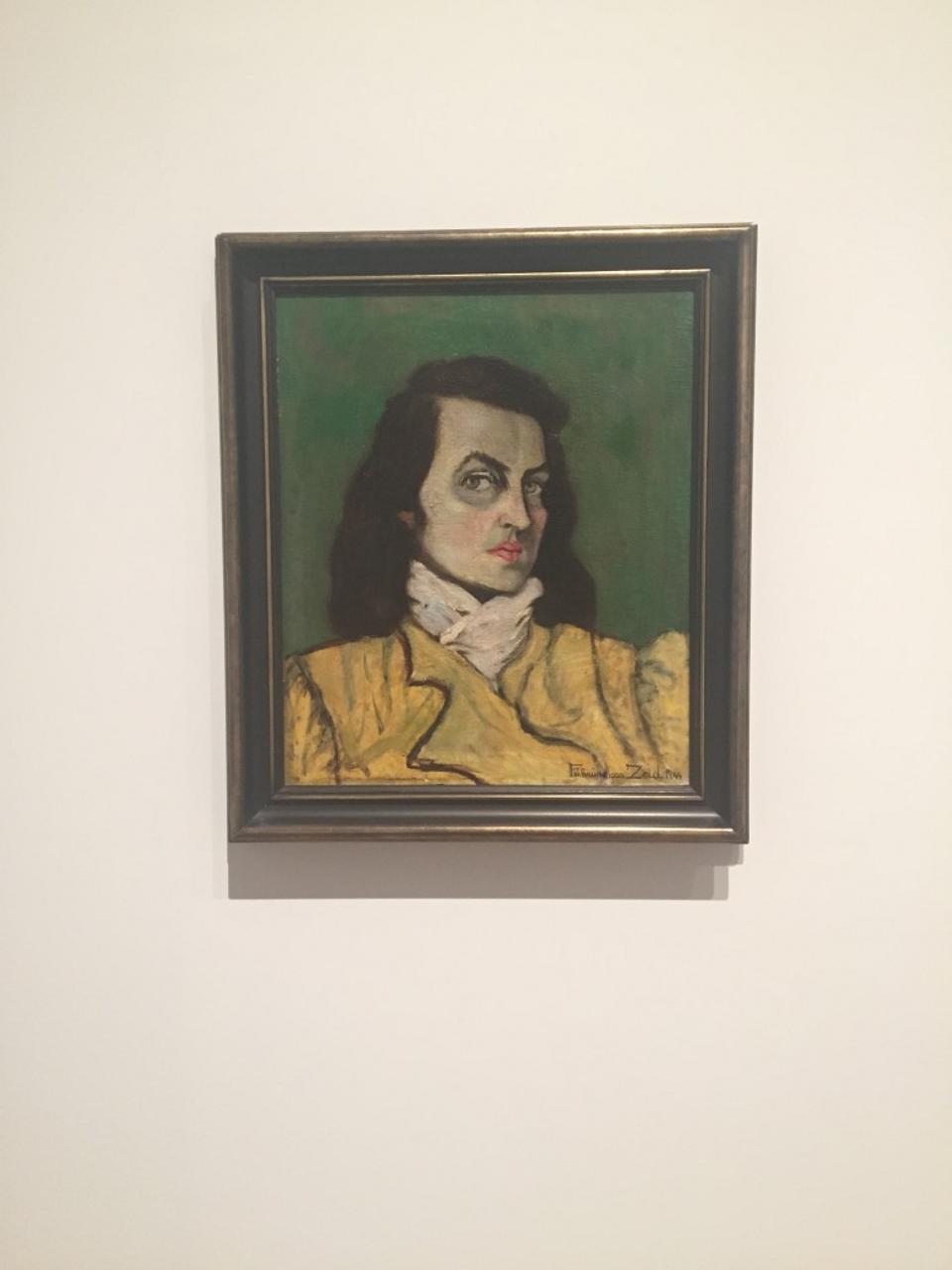
Zeid's self-portrait from 1944, part of the Sema and Barbaros Caga Collection, hangs in the first room, introducing the Turkish female painter. (TRT World and Agencies)
In terms of Fahrelnissa Zeid, it's a conversation that's been happening for many years before we decided to stage this exhibition. We've been very actively looking at the Middle East, looking at artists from Turkey, thinking about how the collection can grow. We actually acquired her work for the collection in advance of this exhibition – which is quite a typical way of working – and wanted to kind of make sense of that and show her work to the public. She's obviously had a lot of attention in Turkey in recent years; in Sharjah [Biennial in 2015] through the Istanbul Biennale [in 2015] and so on, so it was an opportunity to think "Well, how would we look at Fahrelnissa Zeid?" Given she had this really important career in London, how is it that somebody so extravagant, charismatic, such a wonderful artist, could have been neglected?
So that's really kind of the background for this show. This is, as I said, a mid-scale retrospective. It's hung more or less chronologically: It begins with a self portrait from the early 1940s and ends with a work called Someone from the Past which is a self-portrait from 1980. We're very keen to show the span of her career, that she was working across the 20th century pretty much, in some of the most interesting places at some of these very crucial times.
In terms of Fahrelnissa Zeid, it's a conversation that's been happening for many years before we decided to stage this exhibition. We've been very actively looking at the Middle East, looking at artists from Turkey, thinking about how the collection can grow. We actually acquired her work for the collection in advance of this exhibition – which is quite a typical way of working – and wanted to kind of make sense of that and show her work to the public. She's obviously had a lot of attention in Turkey in recent years; in Sharjah [Biennial in 2015] through the Istanbul Biennale [in 2015] and so on, so it was an opportunity to think "Well, how would we look at Fahrelnissa Zeid?" Given she had this really important career in London, how is it that somebody so extravagant, charismatic, such a wonderful artist, could have been neglected?
So that's really kind of the background for this show. This is, as I said, a mid-scale retrospective. It's hung more or less chronologically: It begins with a self portrait from the early 1940s and ends with a work called Someone from the Past which is a self-portrait from 1980. We're very keen to show the span of her career, that she was working across the 20th century pretty much, in some of the most interesting places at some of these very crucial times.
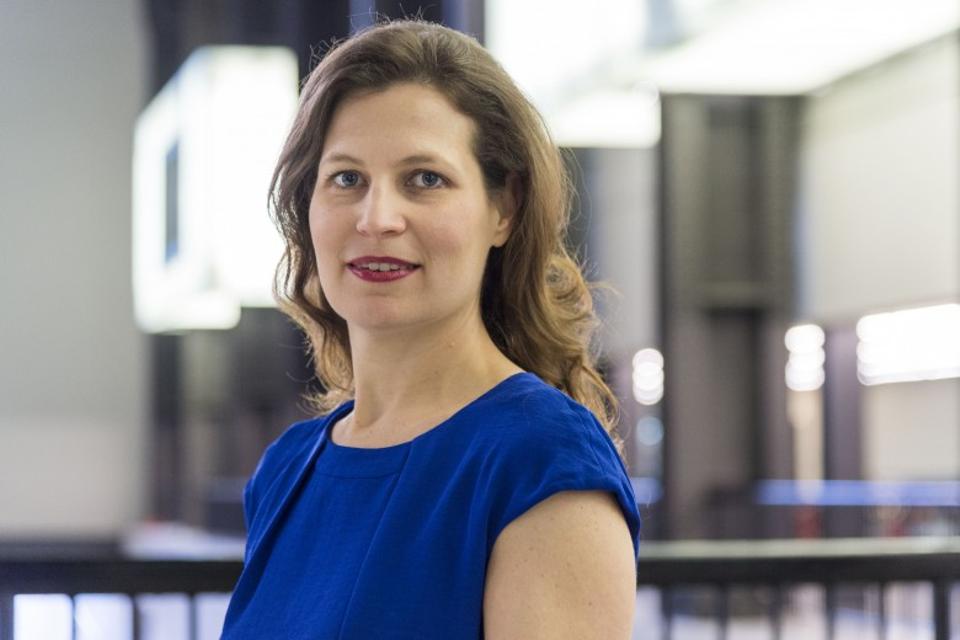
Kerryn Greenberg, along with co-curator Vassilis Oikonomopoulos, has organised the mid-scale retrospective for renowned Turkish artist Fahrelnissa Zeid in the UK at the Tate Modern. (TRT World and Agencies)
In Turkey, of course she was there – and very friendly with Mustafa Kemal Ataturk at a time of great modernisation, rapid change in Turkey. She happened to be in Berlin in the mid- to late-1930s and had an opportunity to meet with Hitler which is kind of an extraordinary story at the time of the rise of Nazism in Germany. And then, of course, her career mostly took place in London and Paris post-[WWII] when those two cities were trying to reestablish themselves after the trauma of the war.
She's an artist, I think, who has had an extraordinary life, created some amazing paintings, often on a very monumental scale, and although those have had a fair amount of exposure in Turkey, they really are not known in the United Kingdom at all. This is a wonderful opportunity for us to look at that work and present it to our audiences.
Fahrelnissa Zeid is a remarkable woman from a remarkable family. Can you tell us a bit about her, and her family?
KG: Yes, of course! She was born in 1901 in Buyukada [the largest of the Princes' Islands off the coast of Istanbul]. Her uncle [Cevat Pasha] was the Grand Vizier, one of the Grand Viziers, I should say. They came from a very modest background initially, and rose up through the Ottoman Empire to be a very prominent and sophisticated and elite family. Her father [Shakir Pasha] had first met her mother [Sara Ismet Hanim] in Crete. He'd been posted there by his brother. [Zeid]… had a relatively privileged upbringing. Her family [was] very artistic, she was exposed to literature, to music, to French, to arts. Her mother was a big influence on her; she painted landscapes and still lifes on silks; her older brother [and uncle's namesake] Cevat had dropped out of Oxford to study art in Rome, and it was also a huge influence on her.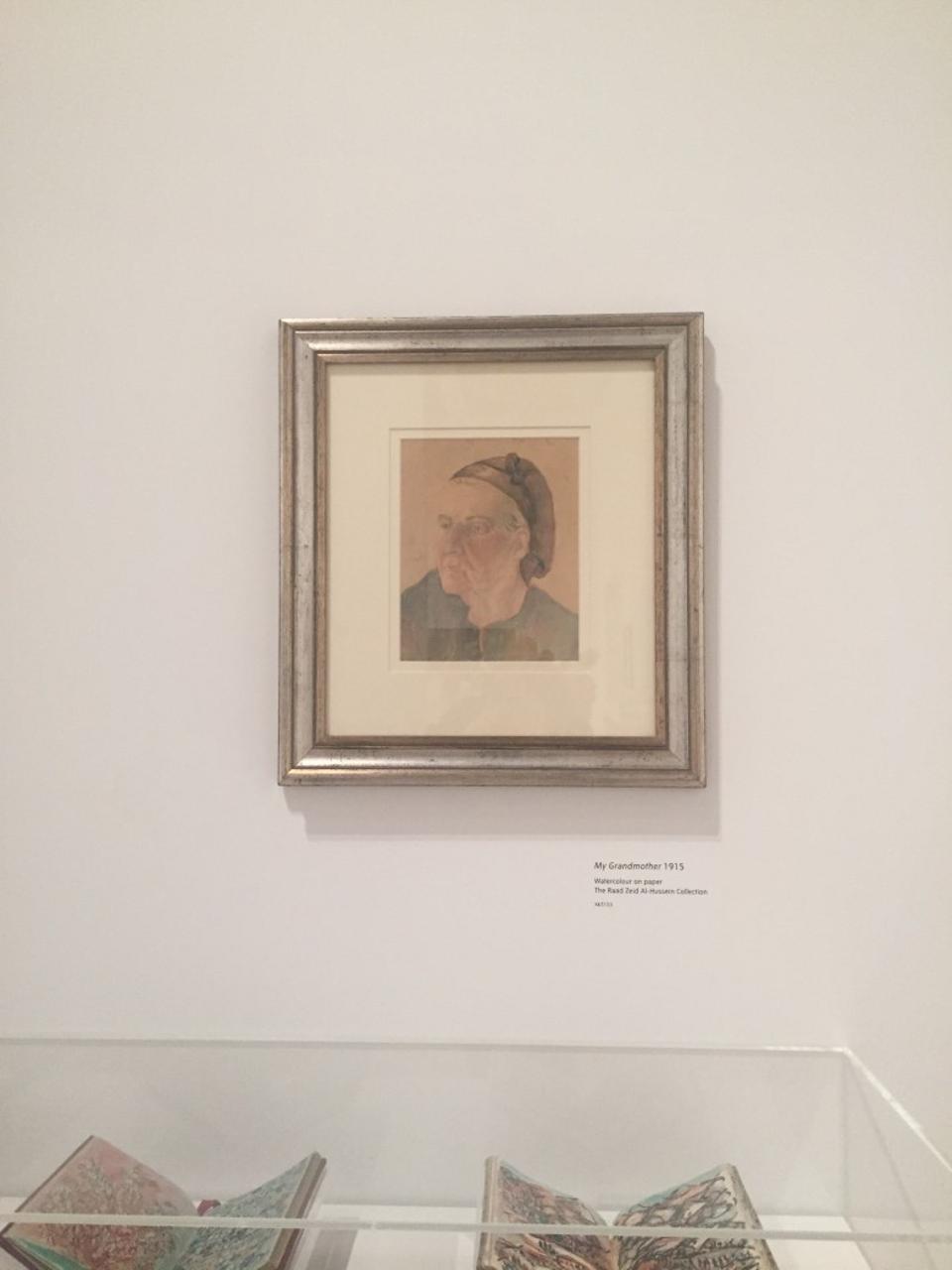
In Turkey, of course she was there – and very friendly with Mustafa Kemal Ataturk at a time of great modernisation, rapid change in Turkey. She happened to be in Berlin in the mid- to late-1930s and had an opportunity to meet with Hitler which is kind of an extraordinary story at the time of the rise of Nazism in Germany. And then, of course, her career mostly took place in London and Paris post-[WWII] when those two cities were trying to reestablish themselves after the trauma of the war.
She's an artist, I think, who has had an extraordinary life, created some amazing paintings, often on a very monumental scale, and although those have had a fair amount of exposure in Turkey, they really are not known in the United Kingdom at all. This is a wonderful opportunity for us to look at that work and present it to our audiences.
Fahrelnissa Zeid is a remarkable woman from a remarkable family. Can you tell us a bit about her, and her family?
KG: Yes, of course! She was born in 1901 in Buyukada [the largest of the Princes' Islands off the coast of Istanbul]. Her uncle [Cevat Pasha] was the Grand Vizier, one of the Grand Viziers, I should say. They came from a very modest background initially, and rose up through the Ottoman Empire to be a very prominent and sophisticated and elite family. Her father [Shakir Pasha] had first met her mother [Sara Ismet Hanim] in Crete. He'd been posted there by his brother. [Zeid]… had a relatively privileged upbringing. Her family [was] very artistic, she was exposed to literature, to music, to French, to arts. Her mother was a big influence on her; she painted landscapes and still lifes on silks; her older brother [and uncle's namesake] Cevat had dropped out of Oxford to study art in Rome, and it was also a huge influence on her.

Zeid's 1915 watercolour portrait of her grandmother, on loan to Tate Modern from her grandson Raad Zeid al Hussein, greets visitors as they enter. (TRT World and Agencies)
The first work in the exhibition, alongside the self-portrait, is a small watercolour painting from 1915, when the artist was only 14 years old is a portrait of her grandmother. So you can see that from a very young age she was painting and drawing and that just continued and accelerated throughout her life. It was a very natural thing for her to do because she came from this artistic family. In 1914, her father was shot and killed. Her brother Cevat [Sakir Kabaagacli, later a famous author under the pen name 'The Fisherman of Halicarnassus'] who, as I said was a hugely important figure in her life, was convicted of manslaughter. And that completely turned her life upside down. A few months later, [WWI] was declared as well, and so all remaining male relatives were called into service. The family were torn apart by these very dramatic and tragic events. Furthermore … at that point, being in school at a French convent ... had provided this kind of safety net, I suppose, with all this personal turmoil going on. Unfortunately, because of the war, the French convent was forced to close. So her life was massively turned upside down. During the war she continued to stay in Istanbul. She then, as soon as the war was over in 1919, she was one of the first women to study at the Fine Arts Academy for Women in Istanbul. A year later, she married Izzet Melih Devrim, a very prominent Turkish writer but also president of the tobacco company [Société de la régie co-intéressée des tabacs de l'empire Ottoman]. It was at that point that she began to be exposed to Western art history because they went to Venice for their honeymoon in 1920. And from there it was regular trips to Europe. That was kind of the redeeming features of a quite a troubled marriage.
She had three children with Devrim: Faruk, who unfortunately died very young from scarlet fever; and then Nejad Devrim, who of course became a very important Turkish painter who had a wonderful career of his own in Paris and beyond; and then also Sirin, who became a dramatist and very involved in the theatre and moved to America.
I could go on and on about her life – she then moves to Berlin, of course, to Baghdad, back to Istanbul, from Istanbul to London, London to Paris …. In between she's travelling all over Europe. In 1950, [she] has a major show in a small commercial gallery [the Hugo Gallery] in New York but a really prominent one where the likes of Warhol and Magritte were also showing. She happens to be in the most interesting places at these momentous moments and I think that very much impacts on the kind of work that she's making. And you can see in terms of tracing her own life story and tracing the stylistic changes in her practise there's a connection.
In this show, what we've tried to do is, set in the first room, give people an introduction to this very rich life and the fact that it does include the death of her firstborn, marrying into a royal family [via her second husband Prince Zeid bin Hussein, the then Iraqi ambassador to Ankara], narrowly escaping political assassination during the Iraqi coup d'etat in 1958 … All these kind of elements that make for an incredibly interesting story but really are the backdrop behind the work, that the work is allowed to have centre stage.
Tate Modern describes Zeid's abstract works as "a synthesis of Islamic, Byzantine, Arab and Persian influences fused with European approaches." Could you elaborate on her influences, both historic and contemporary?
KG: I think often these were subconscious. She describes working in a frenzied state, almost working through the night, almost like...she compares it to being like a volcano erupting lava, which I think is such a lovely quote! She's in touch with herself, she's in touch with the canvas and it's like something is flowing from within her that she cannot stop. I think you can really see that in the brushwork; she's very hurried. There's an imprecise precision in a sense – she knows what she's wanting to achieve, and she's in a hasty kind of execution. She talks about when you step back, when she steps back, and we're just talking to other people being able to synthesise their influences much more clearly once the painting is finished than during the process
The first work in the exhibition, alongside the self-portrait, is a small watercolour painting from 1915, when the artist was only 14 years old is a portrait of her grandmother. So you can see that from a very young age she was painting and drawing and that just continued and accelerated throughout her life. It was a very natural thing for her to do because she came from this artistic family. In 1914, her father was shot and killed. Her brother Cevat [Sakir Kabaagacli, later a famous author under the pen name 'The Fisherman of Halicarnassus'] who, as I said was a hugely important figure in her life, was convicted of manslaughter. And that completely turned her life upside down. A few months later, [WWI] was declared as well, and so all remaining male relatives were called into service. The family were torn apart by these very dramatic and tragic events. Furthermore … at that point, being in school at a French convent ... had provided this kind of safety net, I suppose, with all this personal turmoil going on. Unfortunately, because of the war, the French convent was forced to close. So her life was massively turned upside down. During the war she continued to stay in Istanbul. She then, as soon as the war was over in 1919, she was one of the first women to study at the Fine Arts Academy for Women in Istanbul. A year later, she married Izzet Melih Devrim, a very prominent Turkish writer but also president of the tobacco company [Société de la régie co-intéressée des tabacs de l'empire Ottoman]. It was at that point that she began to be exposed to Western art history because they went to Venice for their honeymoon in 1920. And from there it was regular trips to Europe. That was kind of the redeeming features of a quite a troubled marriage.
She had three children with Devrim: Faruk, who unfortunately died very young from scarlet fever; and then Nejad Devrim, who of course became a very important Turkish painter who had a wonderful career of his own in Paris and beyond; and then also Sirin, who became a dramatist and very involved in the theatre and moved to America.
I could go on and on about her life – she then moves to Berlin, of course, to Baghdad, back to Istanbul, from Istanbul to London, London to Paris …. In between she's travelling all over Europe. In 1950, [she] has a major show in a small commercial gallery [the Hugo Gallery] in New York but a really prominent one where the likes of Warhol and Magritte were also showing. She happens to be in the most interesting places at these momentous moments and I think that very much impacts on the kind of work that she's making. And you can see in terms of tracing her own life story and tracing the stylistic changes in her practise there's a connection.
In this show, what we've tried to do is, set in the first room, give people an introduction to this very rich life and the fact that it does include the death of her firstborn, marrying into a royal family [via her second husband Prince Zeid bin Hussein, the then Iraqi ambassador to Ankara], narrowly escaping political assassination during the Iraqi coup d'etat in 1958 … All these kind of elements that make for an incredibly interesting story but really are the backdrop behind the work, that the work is allowed to have centre stage.
Tate Modern describes Zeid's abstract works as "a synthesis of Islamic, Byzantine, Arab and Persian influences fused with European approaches." Could you elaborate on her influences, both historic and contemporary?
KG: I think often these were subconscious. She describes working in a frenzied state, almost working through the night, almost like...she compares it to being like a volcano erupting lava, which I think is such a lovely quote! She's in touch with herself, she's in touch with the canvas and it's like something is flowing from within her that she cannot stop. I think you can really see that in the brushwork; she's very hurried. There's an imprecise precision in a sense – she knows what she's wanting to achieve, and she's in a hasty kind of execution. She talks about when you step back, when she steps back, and we're just talking to other people being able to synthesise their influences much more clearly once the painting is finished than during the process
.

Zeid's massive 1951 painting, 'My Hell', that Greenberg calls "her masterpiece" was donated to Istanbul Modern by her children, Sirin Devrim and Prince Raad. It is on loan to Tate Modern for the Zeid retrospective. (TRT World and Agencies)
So I think her exposure – I mean Turkey being such an important place [where] East meets West; where there's layers and layers of history … A lot of that was inside her. Whether she was conscious or it was part of her subconscious, it was coming to the fore. I think particularly in these abstract paintings, when you can see the way she's using the black line in order to highlight colour, you can see the influences of stained glass windows. It's exactly that same process, the black leaded line, the iridescent formations of colour, her interest in taking geometry, quite simple forms essentially. In My Hell, where you have the repetition of the triangular shape and it's taking very simple geometric shapes and then building up a more complex pattern that then becomes a very moving composition and I think that's very much something that happens in mosaic, taking little elements and building up a greater image.
In terms of her engagement with Western abstraction, of course she was in Paris and London in the mid- to late-1940s when other artists were questioning "What can art do?" in the wake of [WWII]. "What is the responsibility of artists? How do we make art in a world that has revealed itself to be just so ruthless, essentially?" So I think this idea of transmitting beauty, looking back at nature, and the shapes of nature, the colours of nature, and trying to create something that speaks on a very emotional level, I think, to people's experiences of the world.
So I think her exposure – I mean Turkey being such an important place [where] East meets West; where there's layers and layers of history … A lot of that was inside her. Whether she was conscious or it was part of her subconscious, it was coming to the fore. I think particularly in these abstract paintings, when you can see the way she's using the black line in order to highlight colour, you can see the influences of stained glass windows. It's exactly that same process, the black leaded line, the iridescent formations of colour, her interest in taking geometry, quite simple forms essentially. In My Hell, where you have the repetition of the triangular shape and it's taking very simple geometric shapes and then building up a more complex pattern that then becomes a very moving composition and I think that's very much something that happens in mosaic, taking little elements and building up a greater image.
In terms of her engagement with Western abstraction, of course she was in Paris and London in the mid- to late-1940s when other artists were questioning "What can art do?" in the wake of [WWII]. "What is the responsibility of artists? How do we make art in a world that has revealed itself to be just so ruthless, essentially?" So I think this idea of transmitting beauty, looking back at nature, and the shapes of nature, the colours of nature, and trying to create something that speaks on a very emotional level, I think, to people's experiences of the world.
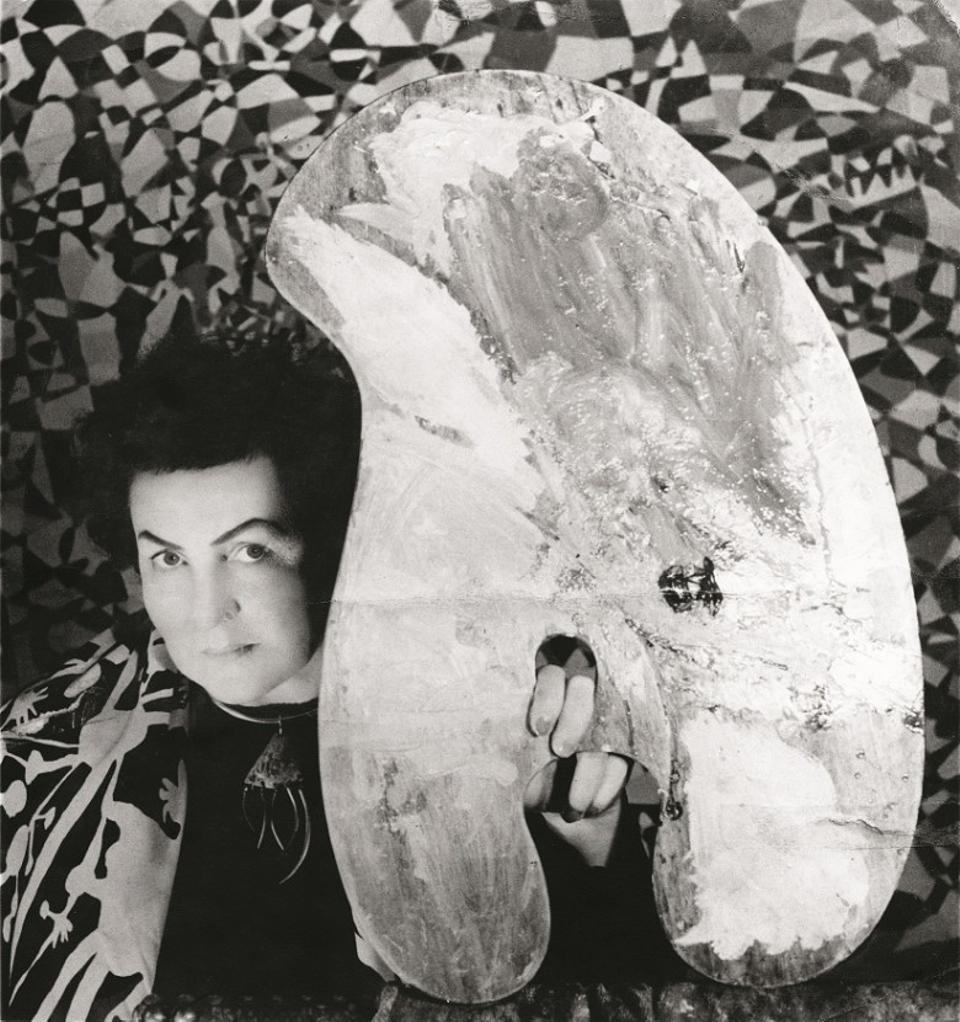
The artist in her studio, circa 1952. (TRT World and Agencies)
So the way that she titles the pieces, even though they're not representative they're still, you know – the Octopus of Triton, Break of the Atom and Vegetal Life – very poetic titles. When you look through her sketchbooks and notebooks you can see her interest in literature and poetry and beauty. By and large she was not a political artist but she was working in heavily contested places at very important moments.
So the way that she titles the pieces, even though they're not representative they're still, you know – the Octopus of Triton, Break of the Atom and Vegetal Life – very poetic titles. When you look through her sketchbooks and notebooks you can see her interest in literature and poetry and beauty. By and large she was not a political artist but she was working in heavily contested places at very important moments.
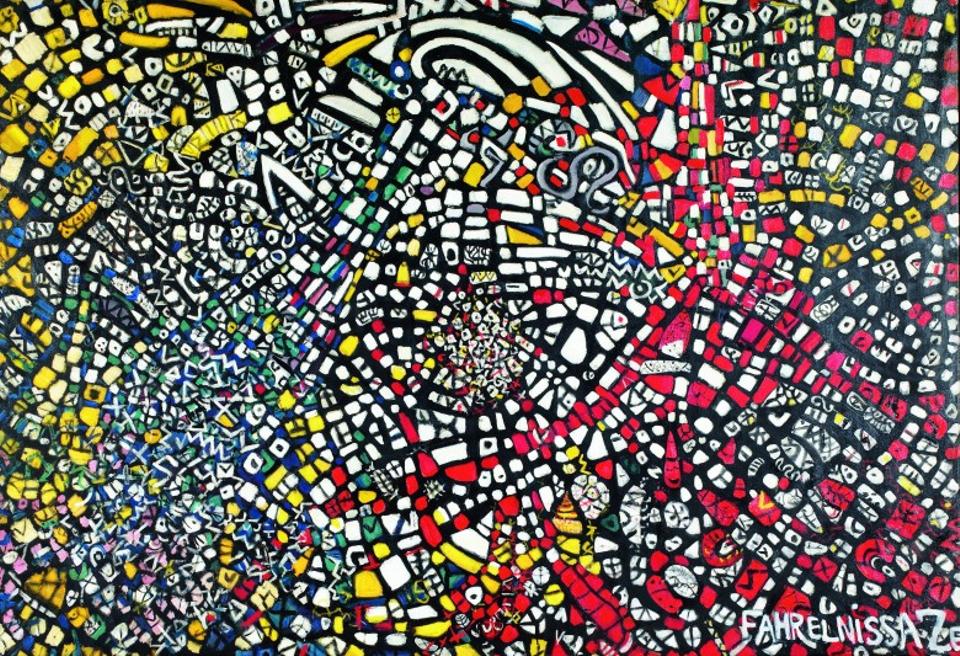
Zeid's paintings, even the non-representative ones, often have imaginative titles, such as 'The Octopus of Triton', an abstract work from 1953. (TRT World and Agencies)
Istanbul Modern, a prominent museum in Turkey, has loaned several pieces for this exhibition, such as 'My Hell' from 1951, an colourful abstract painting on a huge canvas, and 'Resolved Problems' from 1948, another colourful, but smaller abstract painting. Can you tell us about them? Their use of size, colour, shape and pattern, for example?
KG: I think to understand Resolved Problems one has to take a step back to look at Fight Against Abstraction. Because I think there you can see this internal conflict that she's facing between her background, her training in figuration, and this move towards abstraction. I think of Resolved Problems as being one of the first works in which she does resolve that internal conflict. It's a very modestly scaled work [130 x 97 cm], but she's got all the elements, I think, in terms of understanding form, understanding composition, palette, how cool and warm colours can intersect with each other and complement each other ... And that just then explodes into works like The Arena of the Sun, Basel Carnival, and her masterpiece, My Hell, from 1951. Now My Hell has been widely seen in Turkey, of course, because it's in the Istanbul Modern collection but it hasn't been seen in London since 1954 when it was shown at the ICA [The Institute of Contemporary Arts] in this very important exhibition that she had in one of the most important venues in London at the time. So for us to be able to bring all these together I think is a really important moment, and we're very indebted to Istanbul Modern for lending one of the most important pieces in their collection to us.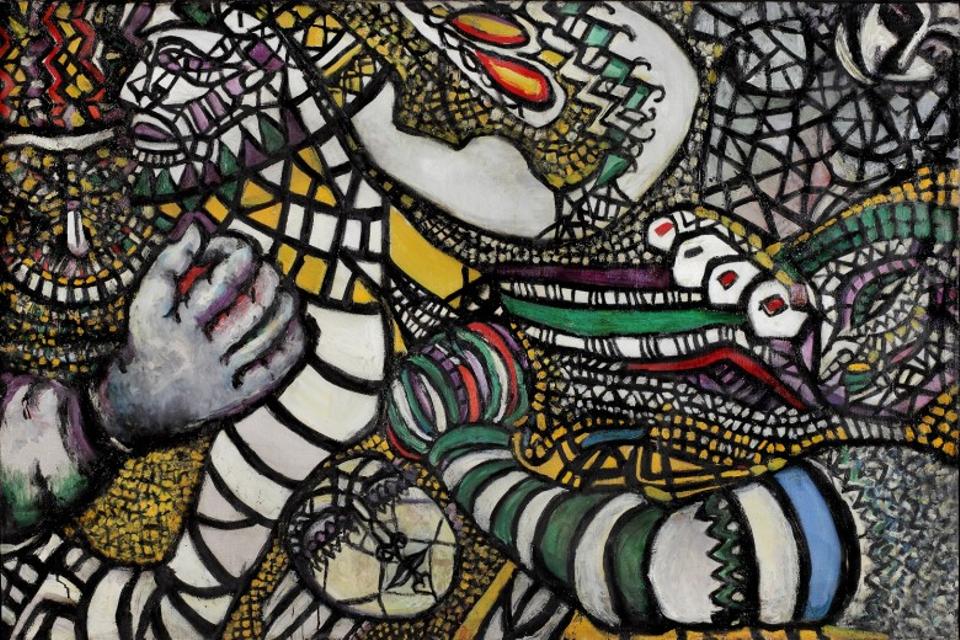
Istanbul Modern, a prominent museum in Turkey, has loaned several pieces for this exhibition, such as 'My Hell' from 1951, an colourful abstract painting on a huge canvas, and 'Resolved Problems' from 1948, another colourful, but smaller abstract painting. Can you tell us about them? Their use of size, colour, shape and pattern, for example?
KG: I think to understand Resolved Problems one has to take a step back to look at Fight Against Abstraction. Because I think there you can see this internal conflict that she's facing between her background, her training in figuration, and this move towards abstraction. I think of Resolved Problems as being one of the first works in which she does resolve that internal conflict. It's a very modestly scaled work [130 x 97 cm], but she's got all the elements, I think, in terms of understanding form, understanding composition, palette, how cool and warm colours can intersect with each other and complement each other ... And that just then explodes into works like The Arena of the Sun, Basel Carnival, and her masterpiece, My Hell, from 1951. Now My Hell has been widely seen in Turkey, of course, because it's in the Istanbul Modern collection but it hasn't been seen in London since 1954 when it was shown at the ICA [The Institute of Contemporary Arts] in this very important exhibition that she had in one of the most important venues in London at the time. So for us to be able to bring all these together I think is a really important moment, and we're very indebted to Istanbul Modern for lending one of the most important pieces in their collection to us.

Zeid's 1947 painting 'Fight Against Abstraction' exposes an "internal conflict that she's facing between … her training in figuration, and this move towards abstraction." (TRT World and Agencies)
This room really begins with Resolved Problems from 1948, and it carries on through the 1950s when she is really making a name for herself as an international abstract female painter. And then concluding with her painting from 1962, Break of the Atom and Vegetal Life, which is not the last abstract painting she makes, but it's becoming one of the last.
Zeid has said "I … cease to be myself in order to become part of an impersonal creative process that throws out these paintings much as an erupting volcano throws out rocks and lava," adding, "Mostly, I become aware of the picture only after it is completed." Do you find her works are as spontaneous as she believed them to be, or was there an underlying dynamic at work?
KG: When you look at how she painted, she would typically sketch out some lines and then block out colour and I think so in some ways that initial sketching out, working out the movements, I think must have happened quite quickly. She had a vision and she was mapping it out. And then she was blocking in the colour to try and test it. So yes, I think she worked quite quickly, but on such a huge scale. I mean My Hell was pinned across the corner of her studio because her studio wasn't big enough to accommodate it. I also think that she was interested in creating an environment – she wants to be surrounded by her works so she would pin them to the ceiling, she would wrap them around the corners of the room, she would invite people to her home in Amman and she would unfurl a large canvas, almost like a red carpet, up towards the steps of her home. She was interested in how people would engage with her practise. So, definitely, this kind of creating a world around her. In terms of the lava [metaphor], she was, at least from her writings, deeply interested in nature. She tried to be in tune with the world around her in quite a deep and spiritual way.
This room really begins with Resolved Problems from 1948, and it carries on through the 1950s when she is really making a name for herself as an international abstract female painter. And then concluding with her painting from 1962, Break of the Atom and Vegetal Life, which is not the last abstract painting she makes, but it's becoming one of the last.
Zeid has said "I … cease to be myself in order to become part of an impersonal creative process that throws out these paintings much as an erupting volcano throws out rocks and lava," adding, "Mostly, I become aware of the picture only after it is completed." Do you find her works are as spontaneous as she believed them to be, or was there an underlying dynamic at work?
KG: When you look at how she painted, she would typically sketch out some lines and then block out colour and I think so in some ways that initial sketching out, working out the movements, I think must have happened quite quickly. She had a vision and she was mapping it out. And then she was blocking in the colour to try and test it. So yes, I think she worked quite quickly, but on such a huge scale. I mean My Hell was pinned across the corner of her studio because her studio wasn't big enough to accommodate it. I also think that she was interested in creating an environment – she wants to be surrounded by her works so she would pin them to the ceiling, she would wrap them around the corners of the room, she would invite people to her home in Amman and she would unfurl a large canvas, almost like a red carpet, up towards the steps of her home. She was interested in how people would engage with her practise. So, definitely, this kind of creating a world around her. In terms of the lava [metaphor], she was, at least from her writings, deeply interested in nature. She tried to be in tune with the world around her in quite a deep and spiritual way.

Zeid painted a portrait of her friend and art critic Rene Barotte in the 1970s, which is now part of the Raad Zeid al Hussein Collection. (TRT World and Agencies)
There are also figurative works such as portraits in this exhibition. Are they the exception to the rule? Could you tell us about them?
KG: She was a painter [who shouldn't be classified simply as abstract or figurative]. She was different things at different points in her life. So yes, the exhibition begins with her self-portrait from the early 1940s, and ends with a late self-portrait. After the coup d'etat in Iraq in 1958 she returns to portraiture and starts to paint people who are very close to her. By this point she's in her early- to mid-sixties, she's seen quite a lot of the world, I think she's very much starting to take stock of her own life and trying to keep people who are close to her and remember them. Even through her abstract period she continues to draw in her sketchbook both figurative sketches – so little portraits, but also landscapes and still lives and so on; little scenes that she wants to remember. So she's never one thing or another thing – she's a complex artist with different layers.
There are also figurative works such as portraits in this exhibition. Are they the exception to the rule? Could you tell us about them?
KG: She was a painter [who shouldn't be classified simply as abstract or figurative]. She was different things at different points in her life. So yes, the exhibition begins with her self-portrait from the early 1940s, and ends with a late self-portrait. After the coup d'etat in Iraq in 1958 she returns to portraiture and starts to paint people who are very close to her. By this point she's in her early- to mid-sixties, she's seen quite a lot of the world, I think she's very much starting to take stock of her own life and trying to keep people who are close to her and remember them. Even through her abstract period she continues to draw in her sketchbook both figurative sketches – so little portraits, but also landscapes and still lives and so on; little scenes that she wants to remember. So she's never one thing or another thing – she's a complex artist with different layers.
No comments:
Post a Comment